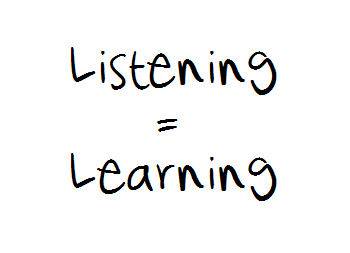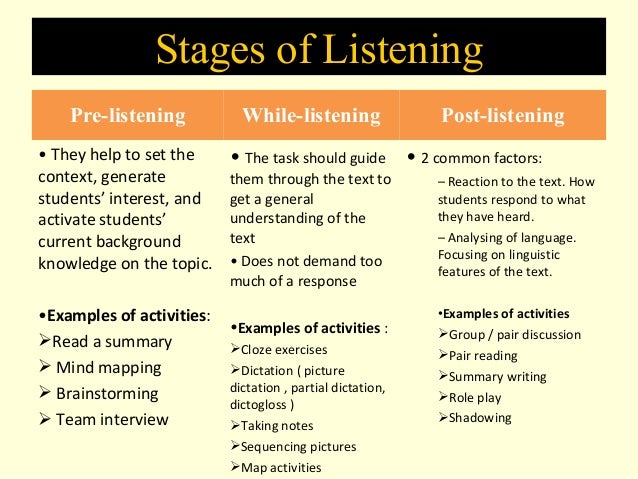Our English listening exercises are very useful for those who want to improve their aural comprehension. In this English listening exercise, we are.

- This resource is rich with ideas, tips, and exercises to help you better communicate and improve your relationships with your family, friends and coworkers.
- Active Listening. Activity ( 10 min ) Choose one activity of the following: Listening Test Game. If you know this test please do not reveal the answers to others. Do not make any sounds when you figure out the answer as it may give a clue to others. Pretend that you are a bus driver. It is your job to drive the Main Street Bus.
Time Required
At least 10 minutes. Try to make time for this practice at least once per week.

How to Do It
Find a quiet place where you can talk with a conversation partner without interruption or distraction. Invite this person to share what's on their mind. As they do so, try to follow the steps below. You don't need to cover every step, but the more you do cover, the more effective this practice is likely to be.

- Paraphrase. Once the other person has finished expressing a thought, try to paraphrase what they said to make sure you understand and to show that you are paying attention. Helpful ways to paraphrase include 'What I hear you saying is…,' 'It sounds like…,' and 'If I understand you right….'
- Ask questions. When appropriate, ask questions to encourage the other person to elaborate on their thoughts and feelings. Try to avoid jumping to conclusions about what the other person means. Instead, ask questions to clarify their meaning, such as, 'When you say_____, do you mean_____?'
- Express empathy. If the other person voices negative feelings, strive to validate these feelings rather than questioning or defending against them. For example, if the speaker expresses frustration, try to consider why they feel that way, regardless of whether you think that feeling is justified or whether you would feel that way yourself were you in that person's position. You might respond, 'I can sense that you're feeling frustrated,' and even 'I can understand how that situation could cause frustration.'
- Use engaged body language. You can show that you are engaged and interested by making eye contact, nodding, facing the other person, and maintaining an open and relaxed body posture. Try to avoid attending to distractions in your environment or checking your phone. Be mindful of your facial expressions: Avoid expressions that might communicate disapproval or disgust.
- Avoid judgment. Your goal is to understand the other person's perspective and accept it for what it is, even if you disagree with it. Try not to interrupt with counter-arguments or mentally prepare a rebuttal while the other person is speaking.
- Avoid giving advice. Problem-solving is likely to be more effective after both conversation partners understand one another's perspective and feel heard. Moving too quickly into advice-giving can be counterproductive.
- Take turns. After the other person has had a chance to speak and you have engaged in the active listening steps above, ask if it's okay for you to share your perspective. When sharing your perspective, express yourself as clearly as possible using 'I' statements (e.g., 'I feel overwhelmed when you don't help out around the house.'). It may also be helpful, when relevant, to express empathy for the other person's perspective (e.g., 'I know you've been very busy lately and don't mean to leave me hanging.').
Why You Should Try It
Often we'll listen to a conversation partner without really hearing them. In the process, we miss opportunities to connect with that person—and even risk making them feel neglected, disrespected, and resentful.
This exercise helps you express active interest in what the other person has to say and make them feel heard—a way to foster empathy and connection. This technique is especially well-suited for difficult conversations (such as arguments with a romantic partner) and for expressing support. It may also help facilitate constructive conversations across political, cultural, or other differences; however, studies have found that, when there's a power imbalance between people of different groups, it's more important for the person with less social power to give their perspective while the person with more social power listens and tries to take their perspective. Research suggests that using this technique can help others feel more understood and improve relationship satisfaction.

- This resource is rich with ideas, tips, and exercises to help you better communicate and improve your relationships with your family, friends and coworkers.
- Active Listening. Activity ( 10 min ) Choose one activity of the following: Listening Test Game. If you know this test please do not reveal the answers to others. Do not make any sounds when you figure out the answer as it may give a clue to others. Pretend that you are a bus driver. It is your job to drive the Main Street Bus.
Time Required
At least 10 minutes. Try to make time for this practice at least once per week.
How to Do It
Find a quiet place where you can talk with a conversation partner without interruption or distraction. Invite this person to share what's on their mind. As they do so, try to follow the steps below. You don't need to cover every step, but the more you do cover, the more effective this practice is likely to be.
- Paraphrase. Once the other person has finished expressing a thought, try to paraphrase what they said to make sure you understand and to show that you are paying attention. Helpful ways to paraphrase include 'What I hear you saying is…,' 'It sounds like…,' and 'If I understand you right….'
- Ask questions. When appropriate, ask questions to encourage the other person to elaborate on their thoughts and feelings. Try to avoid jumping to conclusions about what the other person means. Instead, ask questions to clarify their meaning, such as, 'When you say_____, do you mean_____?'
- Express empathy. If the other person voices negative feelings, strive to validate these feelings rather than questioning or defending against them. For example, if the speaker expresses frustration, try to consider why they feel that way, regardless of whether you think that feeling is justified or whether you would feel that way yourself were you in that person's position. You might respond, 'I can sense that you're feeling frustrated,' and even 'I can understand how that situation could cause frustration.'
- Use engaged body language. You can show that you are engaged and interested by making eye contact, nodding, facing the other person, and maintaining an open and relaxed body posture. Try to avoid attending to distractions in your environment or checking your phone. Be mindful of your facial expressions: Avoid expressions that might communicate disapproval or disgust.
- Avoid judgment. Your goal is to understand the other person's perspective and accept it for what it is, even if you disagree with it. Try not to interrupt with counter-arguments or mentally prepare a rebuttal while the other person is speaking.
- Avoid giving advice. Problem-solving is likely to be more effective after both conversation partners understand one another's perspective and feel heard. Moving too quickly into advice-giving can be counterproductive.
- Take turns. After the other person has had a chance to speak and you have engaged in the active listening steps above, ask if it's okay for you to share your perspective. When sharing your perspective, express yourself as clearly as possible using 'I' statements (e.g., 'I feel overwhelmed when you don't help out around the house.'). It may also be helpful, when relevant, to express empathy for the other person's perspective (e.g., 'I know you've been very busy lately and don't mean to leave me hanging.').
Why You Should Try It
Often we'll listen to a conversation partner without really hearing them. In the process, we miss opportunities to connect with that person—and even risk making them feel neglected, disrespected, and resentful.
This exercise helps you express active interest in what the other person has to say and make them feel heard—a way to foster empathy and connection. This technique is especially well-suited for difficult conversations (such as arguments with a romantic partner) and for expressing support. It may also help facilitate constructive conversations across political, cultural, or other differences; however, studies have found that, when there's a power imbalance between people of different groups, it's more important for the person with less social power to give their perspective while the person with more social power listens and tries to take their perspective. Research suggests that using this technique can help others feel more understood and improve relationship satisfaction.
Why It Works
Active listening helps listeners better understand others' perspectives and helps speakers feel more understood and less threatened. This technique can prevent miscommunication and spare hurt feelings on both sides. By improving communication and preventing arguments from escalating, active listening can make relationships more enduring and satisfying. Practicing active listening with someone close to you can also help you listen better when interacting with other people in your life, such as friends or co-workers.
Evidence That It Works
Weger, H., Castle Bell, G., Minei, E. M., & Robinson, M. C. (2014). The relative effectiveness of active listening in initial interactions. International Journal of Listening, 28(1), 13-31.
Participants had brief conversations (about their biggest disappointment with their university) with someone trained to engage in active listening, someone who gave them advice, or someone who gave simple acknowledgments of their point of view. Participants who received active listening reported feeling more understood at the end of the conversation.
Bruneau, E. G., & Saxe, R. (2012). The power of being heard: The benefits of ‘perspective-giving' in the context of intergroup conflict. Journal of Experimental Social Psychology, 48(4), 855-866.
One study paired Mexican immigrants with White Americans while another paired Israelis with Palestinians. In both studies, each member of the pair was asked to share their perspectives on the difficulties of life in their society, and to take the perspective of the other person when he or she was sharing their views. Results suggest that this dialogue significantly improved participants' attitudes toward the other group—for instance, they felt greater empathy for their suffering, trusted their intentions more, and felt more warmly toward their group as a whole. However, for members of the pair with less social power (e.g., Mexican immigrants or Palestinians), attitudes toward the other group improved more after they gave their perspective than after they took the other person's perspective.
Sources
Instructions adapted from: Markman, H., Stanley, S., & Blumberg, S.L. (1994). Fighting for your marriage. San Francisco: Jossey-Bass Publishers.
Quick Description
Active Listening involves approaching a conversation with a genuine desire to understand the other person's feelings and perspective, without judgment or defensiveness. When you engage in Active Listening, you tune into what your conversation partner is communicating with their words and body language. How well do you feel and understand what others are feeling? Take the Empathy quiz to find out.
Free English listening tests, listening activities for students, and matching audio files! from 123 Listening.
English audio to download with matching worksheets by category:
Active Listening Exercises Worksheets
adjectives set 1;adjectives set 2
animals set 1; animals set 2
body parts
Christmas
classroom
colors
daily routines
feelings and emotions
food
prepositions of place
verbs set 1; verbs set 2; verbs set 3
weather
morelistening exercises...
daily routines
feelings and emotions
food
prepositions of place
verbs set 1; verbs set 2; verbs set 3
weather
Listening worksheet templates:
choose from 2 images
choose from 3 images
choose from two images and write the answer
match the picture to the number
match the picture and write the answer
These are great and allow you to make your own worksheets and resources to match your listening scripts using images. LOTE teachers can use these for Spanish listening test resources, French listening test materials and other languages as well!
123Listening.com is a website built and maintained by MES-English.com and Dream English.com. Many different audio downloads and many different worksheets that can be combined to be very simple for young learners or more difficult for older students.
DreamEnglish.com offers free mp3 downloads with chants and songs for children, lesson and games ideas, 2 CDs packed with great songs for children. Let's sing!
Active Listening Exercises
The listening scripts and worksheets from 123Listening.com were designed around vocabulary sets from MES-English. Visit MES-English.com for resources that match 123listening.com tests including: free printable flashcards, game cards, bingo cards, worksheets, crosswords, wordsearches, and language games!
Active Listening Exercises For Sales
Happy teaching - Mark and Matt
